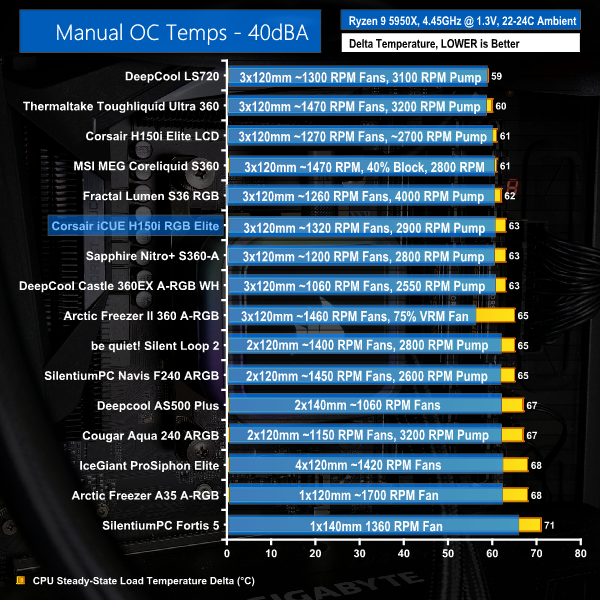Test System:
- Processor: AMD Ryzen 9 5950X
- Overclocked Settings: 4.45GHz all-core @ 1.312V (UEFI), Medium LLC – around 1.3V delivered
- Motherboard: Gigabyte B550 Aorus Master
- Memory: 32GB (2x16GB) Corsair Vengeance LPX 3600MHz 16-18-18-36 DDR4 @ 1.35V
- Graphics Card: Gigabyte RTX 2060 Super 0dB Mode
- Chassis: Fractal Design Meshify 2
- Chassis Fans: 2x140mm 1000 RPM Fractal Front Intake, 1x140mm 1000 RPM Fractal Rear Exhaust, 1x140mm 1000 RPM be quiet! Pure Wings 2 Roof Exhaust (for air cooler testing)
- Power Supply: Seasonic Prime TX-1000
- Operating System: Windows 10 Pro 64-bit
Testing Methodology:
- For testing, we use a 30-minute looped run of Cinebench R23 and record the steady-state CPU temperature at the end of the test. This ensures that the CPU has had ample time to warm up and reach steady state under all of the coolers.
- Ambient is maintained around 22-24 degrees Celsius. Where there is variation beyond this temperature range, we add in extra repeated tests to ensure consistency.
- We show delta temperatures, meaning the ambient temperature is subtracted from the original CPU temperature, and those figures are presented in the charts for more accurate and reliable comparative data.
- We also test each cooler with at least two fresh installs (typically three) to mitigate the likelihood of a dodgy mount spoiling results.
Test Results:
Acoustics
Let’s start off with noise performance at 100% fan speed. This is important for getting an indication of where our performance expectations should lie based on noise output.
Running at 52 dBA full noise output, the Corsair iCUE H150i RGB Elite certainly isn’t a quiet CPU cooler. In fact, with those triple-fans blasting air, it is one of the loudest coolers that we have tested.
The key saving grace is that Corsair provides excellent and easily tuneable fan speed control inside iCUE. The lower limit of 400 RPM and competent zero RPM mode will come in handy.
Despite high 100% fan speed noise levels, we only had to reduce the fans’ duty cycles to 70% to achieve our 40dBA target. Interestingly, this resulted in a recorded speed of 1320 RPM according to iCUE. The pump was maintained at 2900 RPM, though there’s plenty of flexibility for adjusting its speed within the Corsair software.
Thermal Performance
As we often see, high noise output is not very appealing for one’s ears. But it does bring with it strong cooling performance from the Corsair H150i RGB Elite.
A delta temperature of 58C on our overclocked Ryzen 9 5950X is strong. This puts Corsair up against some other 360mm AIOs, notably the Asetek MSI MEG Coreliquid S360.
With that said, Corsair’s unit is far more expensive than the Fractal and DeepCool 360mm AIOs that it is matching. So, you’re going to have to put a hefty premium on the value of Corsair’s warranty, design, and ecosystem.
The reduction in fan speed duty cycle is less significant on the Corsair H150i RGB Elite than with some competing coolers, but the new 360mm unit still gets hit hard by the reduction to 1320 RPM fan speeds.
We observe a delta temperature of 63C. This puts the Corsair unit level with an Asetek Sapphire competitor, as well as the DeepCool Castle. Both of those coolers are cheaper, though, and the Fractal Lumen S36 RGB has stretched to a lead over Corsair’s pricier cooler.
I’d say that these 40dBA thermal results are OK, but not outstanding for Corsair.
As always, it is critical to note that small difference in the displayed delta temperatures are not as important for our PBO testing because the clock speed and cooling power achieved are more important metrics.
PBO sees the H150i RGB Elite falling roughly in-line with the rest of its performance showing. Corsair’s new cooler is a bit better than the DeepCool Castle 360EX and the Fractal Lumen S36, but some of the Asetek big boys will manage to squeeze out another few clicks on the core ratio multiplier.
VRM cooling performance is uninspiring, as we expect from a typical AIO liquid cooler. In fact, Corsair’s AirGuide technology on the fans should mean that the flow of air is more focussed through the radiator and therefore is less likely to interact with the VRM area.
So, I guess the cooler is doing its job, based on this set of results.
 KitGuru KitGuru.net – Tech News | Hardware News | Hardware Reviews | IOS | Mobile | Gaming | Graphics Cards
KitGuru KitGuru.net – Tech News | Hardware News | Hardware Reviews | IOS | Mobile | Gaming | Graphics Cards









